Cold Air Intake System Design and Testing
Our intake system started out simple using a combination of silicon steel and some other sheet metal parts. In dealing with other cars with MAF (Mass Air Flow) sensors we knew it was important to keep diameters and orientation of the sensor similar to stock. Looking to make the intake the best we could, and knowing customers would be wanting a true cold air intake we starting working toward that goal. But we quickly found that there wasn't an easy way, or a cost effective way to make a true cold air intake. Since there was a nice scoop on the Cooper S we thought maybe we could use this to feed cold air to out intake. So before we got too far we went to the dyno and started testing.
Our initial test of the intake system was done with the OEM hood scoop left in place. So we did 3 quick runs with the scoop on and 4 quick runs with the scoop off. In order to determine if the scoop is going to work to feed our intake with cold air, we setup temperature probes all over the car and hooked them to our data logging system. We mounted probes behind the filter (testing the air temp the filter would see), one in the scoop for ambient temp, one pre intercooler and one post intercooler. With the hood scoop plug in place, the filter temps constantly climbed. In 3 quick (10 second interval) runs, the temps at the filter rose to 150 degrees and NO Horsepower was gained. With the scoop plug removed, an instant 30F drop occurred! After 4 runs the temps continued to drop to about 10F over ambient temp which is the same kind of temps found in most typical cold air intakes. This cooler air temp also showed a nice change in Wheel HP and Torque. The 10HP gain was somewhat expected with the cooler temps and also the high flow nature of the air filter.
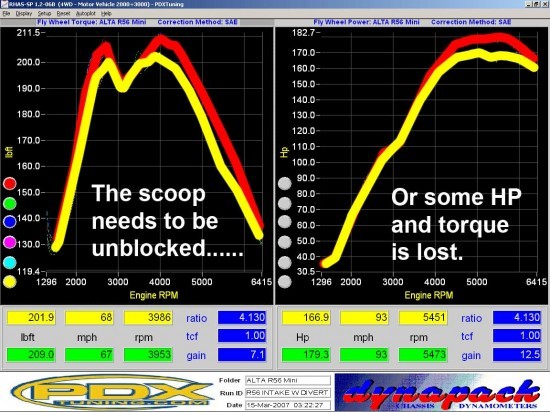 |
Scoop removed makes a difference
This back to back run shows with the OEM scoop plug in and with it removed. This plays a key roll in making the ALTA Cold Air Intake a "cold air intake" |
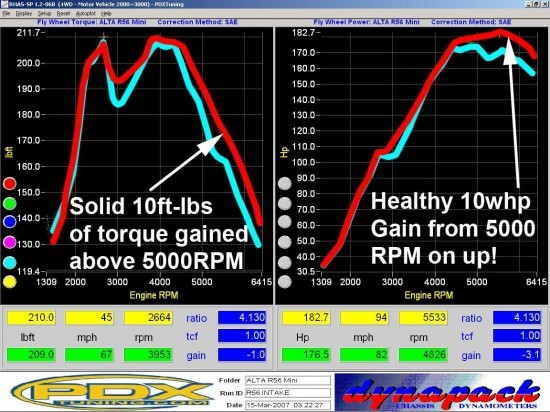 |
Final horsepower gains 10WHP!
This back to back run shows with the OEM scoop plug removed of course! We found 10WHP on a stock tuned 07 Cooper S. Besides the HP, it makes a bunch of cool new sounds! |
So did we need to make the intake any different than our prototype and or add a crazy hood scoop to make it more like a typical cold air intake? NO! With all this great data, it was easy to make the decision to stay away from a more complicated, more expensive "Cold Air" type design. There was no need to make it more complicated knowing that we could provide ample fresh air to the filter with just removal of the scoop!
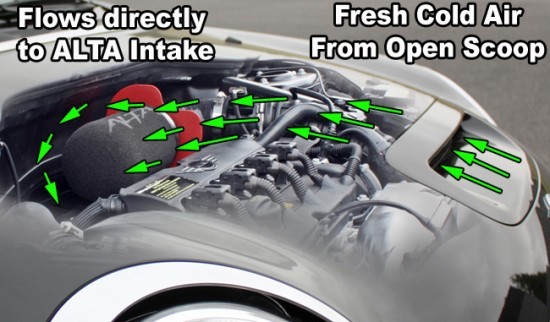
More and More Dyno Results
After our initial test on a completely stock 07+ Cooper S, we knew that we would find similar if not better gains on a Cooper S with an exhaust system installed. with our 3" Turbo-back exhaust installed, we were seeing the bulk of the gains at higher RPM, but still close to 10WHP. Below is the graph showing our averaged gains.
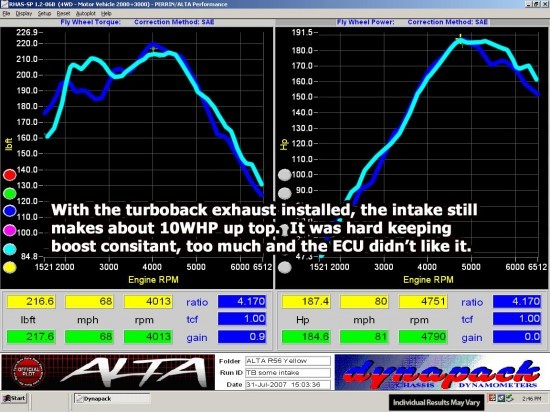 |
Results with turbo back exhaust
You can see there is a large gain at lower RPM, but some of this was due to the car running 2psi more boost there. The boost from there on up was the same as the previous run. This shows that the OEM intake is still a restriction at the upper RPM's with a turboback exhaust installed. |
JCW Cold Air Intake Testing
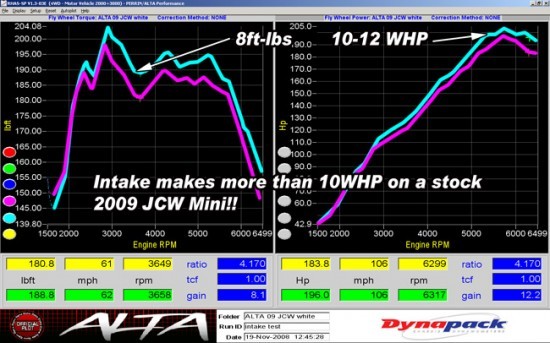 |
Stock JCW with ALTA Intake installed
With many many tests performed on our JCW, we had to do a few intake tests to see if we would see the same HP gains as we do on the Cooper S. On these cars Mini installed a scoop with a few holes in it. While it is better than the old car its still important to remove this scoop to ensure you get maximum air flow to your ALTA intake. |
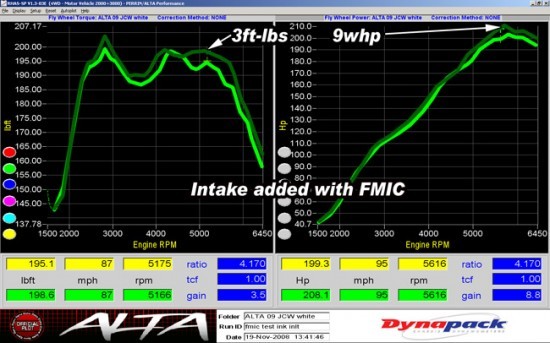 |
Stock JCW with ALTA Intake installed
Just as we had shown on the Cooper S, 10 or so Wheel HP was had with the intake installed on a JCW! Also just as we had shown on the Cooper S. car, the bulk of the power is from 5000 on up which is similar to what we see on this car! One more test we did was the same JCW but with our larger Intercooler installed. Again, the only thing changed between runs was the OEM intake for the ALTA intake. |
Update August 6, 2012
The is a test we did recently to prove that our cold air intake does make a difference in all stages of power. As you see above, we have lots of graphs that show gains on stock cars and tuned cars, but this was a test that we did backwards. We took our 2012 JCW, installed an AccessPORT, ALTA FMIC, ALTA Cold Air Intake, and our JCW catback (leaves stock downpipe). We did some tweaking to the map to get a bit more HP and ended with 241 WHP and 276ft-lbs of TQ you see below on the blue line. This is pretty common for a Stage 3 type setup. We then installed a stock air box with new filter and dynoed the car again. The green line shows the results.
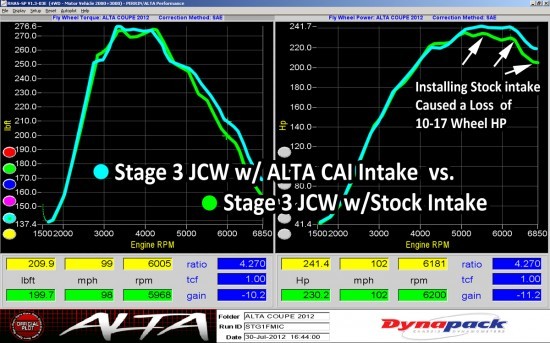
Big surprise, it lost HP!!! Of course it will, the stock intake is a restriction, and at this power level you can really see where this comes into play. Almost 20 WHP is lost at 6800, that is very noticeable and for sure going to kill some of the fun in your Mini. This was a great test and one of the first times we went backwards to prove a part.
Conclusion
This simple design allows us to make a cost effective, high flowing intake system that you see today. To this day, it's the most popular intake for your 07+ Mini cooper and most importantly, the only intake proven to make HP! To this day our competitors push that our intake is not a true cold air but with proof like this how can they really argue!



 Big surprise, it lost HP!!! Of course it will, the stock intake is a restriction, and at this power level you can really see where this comes into play. Almost 20 WHP is lost at 6800, that is very noticeable and for sure going to kill some of the fun in your Mini. This was a great test and one of the first times we went backwards to prove a part.
Big surprise, it lost HP!!! Of course it will, the stock intake is a restriction, and at this power level you can really see where this comes into play. Almost 20 WHP is lost at 6800, that is very noticeable and for sure going to kill some of the fun in your Mini. This was a great test and one of the first times we went backwards to prove a part.





